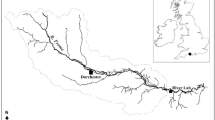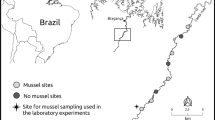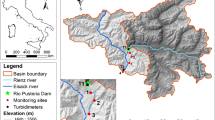Abstract
Responses of the benthic insect community of a southern Appalachian trout stream to inorganic sedimentation and nutrient enrichment were monitored over a period of eight months. Entry of pollutants from point sources established differentially polluted zones, allowing an assessment of impacts due to sedimentation alone and in association with elevated nutrient levels. Input of sediment resulted in a significant increase in bed load and decrease of pH at the substrate-water interface (P < 0.05). The zone receiving nutrient runoff from livestock pasture exhibited elevated levels of nitrate and phosphate, but available data indicated such concentrations to be quite low. Species richness, diversity, and total biomass of filter feeding Trichoptera and Diptera, predaceous Plecoptera, and certain Ephemeroptera were significantly reduced in the polluted zones. Inorganic sedimentation, operating indirectly through disruption of feeding and filling of interstitial spaces, was considered to be the primary factor affecting filter feeding taxa. Decomposition of compounds associated with materials in the bed load may depress pH and eliminate acid sensitive species of Plecoptera and Ephemeroptera. Such processes of acidification may be particularly important to Appalachian streams since the pH of regional surface waters is characteristically acidic prior to sedimentation. Accumulation of particles on body surfaces and respiratory structures, perhaps as a function of wax and mucous secretion or surface electrical properties, appears to be the major direct effect of inorganic sedimentation on stream insects. Growths of the filamentous bacterium Sphaerotilus natans were also frequently associated with silted individuals in the zone receiving nutrient addition. Distribution of the bacterium suggested that silted substrates, perhaps as related to the presence of iron compounds, are required for colonization in dilute nutrient solutions. The primary effect of Sphaerotilus colonies appears to be augmentation of particle accumulation through net formation by bacterial filaments. Data indicate that inorganic sedimentation and nutrient addition operate synergistically, eliminating a significantly greater number of taxa than exposure to one pollutant alone.
Similar content being viewed by others
References
American Public Health Association, 1976. Standard Methods for the Examination of Water and Wastewater, 14th edn. Washington, D.C. 1448 p.
Anderson, N. H. & Sedell, J. R., 1979. Detritus processing by macroinvertebrates in stream ecosystems. Ann. Rev. Ent. 24: 351–377.
Bachmann, R. W., 1980. The role of agricultural sediments and chemicals in eutrophication. J. Water Poll. Cont. Fed. 52: 2425–2432.
Bartsch, A. F., 1948. Biological aspects of stream pollution. Sewage Works J. 20: 292–302.
Boccardy, J. A. & Spaulding, W. M., 1968. Effects of surface mining on fish and wildlife in Appalachia. Bur. Sport Fish. Wildl. Resour. Pub. No. 65. 43 p.
Bradt, P. T., 1978. Longitudinal variation in the macroinvertabrate fauna and water chemistry of an eastern Pennsylvania trout stream. In: Thorp, J. J. & Gibbons, J. W. (eds) Energy and Environmental Stress in Aquatic Systems, pp. 771–784. DOE Symposium Series CONF-771114. Washington, D.C.
Brundritt, J. K., 1971. A device for determining velocity of flow near the substrate. Limnol. Oceanogr. 14: 120–123.
Buchanan, B. R. & Gibbons, W. E. (eds), 1975. Bergey's Manual of Determinative Bacteriology, 8th edn. Williams & Wilkins, Baltimore. 843 pp.
Coffman, W. P., Cummins, K. W. & Wuycheck, 1971. Energy flow in a woodland stream ecosystem: I. Tissue support trophic structure of the autumnal community. Arch. Hydrobiol. 68: 232–276.
Cordone, A. J. & Pennoyer, S., 1960. Notes on silt pollution in the Truckee River drainage. Calif. Fish and Game Dept, Inland Fish. Admin. Rep. 60–14. 23 pp.
Cordone, A. J. & Kelley, D. W., 1961. The influences of inorganic sediment on the aquatic life of streams. Calif. Fish Game 47: 189–228.
Cummins, K. W., 1973. Trophic structure and relations of aquatic insects. Ann. Rev. Ent. 18: 183–206.
Cummins, K. W., 1974. Structure and function of stream ecosystems. BioScience 24: 631–641.
Cummins, K. W. & Klug, M. J., 1979. Feeding ecology of stream invertebrates. Ann. Rev. Ecol. Syst. 10: 147–172.
Dance, K. W. & Hynes, H. B. N., 1980. Some effects of agricultural land use on stream insect communities. Environ. Pollut. 22: 19–28.
Duchrow, R. M. & Everhart, W. H., 1971. Turbidity measurement. Trans. Am. Fish. Soc. 100: 682–690.
Finstein, M. S., 1972. Pollution Microbiology. Marcel Dekker, New York. 168 pp.
Gammon, J. R., 1970. The effect of inorganic sediment on stream biota. U.S. EPA, Water Pollut. Res. Ser. Rep. EPA-660/3–73–004. 141 pp.
Gaufin, A. R., 1973. Water quality requirements of aquatic insects. U.S. EPA, Water Pollut. Res. Ser. Rep. 18050DWC12/70. 89 pp.
Harsbarger, T. J., 1975. Factors affecting regional trout stream productivity. In: U.S.D.A., Forest Serv. Southeastern Trout Resources: Ecology and Management Symposium Proceedings, pp. 11–27. Washington, D.C.
Hilsenhoff, W. L., 1975. Aquatic insects of Wisconsin. Tech. Bull. No. 89. Dept. Nat. Resour., Madison, Wisconsin. 89 pp.
Hobbie, J. E. & Likens, G. E., 1973. Output of phopshorus, dissolved organic carbon, and fine particulate carbon from Hubbard Brook watersheds. Limnol. Oceanogr. 18: 734–742.
Hrubant, G. R., Rhodes, R. A. & Sloneker, J. H., 1978. Specific composition of representative feedlot wastes: a chemical and microbial profile. U.S.D.A. Pub. SEA-NC-59. Washington, D.C. 94 pp.
Hrubant, G. R. & Detroy, R. W., 1980. Composition and fermentation of feedlot wastes. In: Moo-Young, M. & Farquhar, G. J. (eds) Waste Treatment and Utilization, pp. 411–424. Pergammon Press, New York.
Hynes, H. B. N., 1970. The Ecology of Running Waters. Liverpool Univ. Press, Liverpool. 555 pp.
Karr, J. R. & Schlosser, I. J., 1977. Impact of nearstream vegetation and stream morphology on water quality and stream biota. U.S. EPA, Ecol. Res. Ser. Rep. EPA-600/3–77–097. 90 pp.
Khaleel, R., Reddy, K. R. & Overcash, M. R., 1980. Transport of potential pollutants in runoff water from land areas receiving animal wastes: a review. Water Res. 14: 421–436.
King, D. L. & Ball, R. C., 1964. The influence of highway construction on a stream. Michigan State Agr. Exp. Sta. Res. Rep. No. 19. 16 pp.
King, P. B., Neuman, R. B. & Hadley, J. B., 1968. Geology of Great Smoky Mountains National Park, Tennessee and North Carolina. Geol. Surv. Prof. Pap. No. 587. Washington, D.C. 23 pp.
Lockhart, N. C., 1980a. Electrical properties and the surface characteristics and structure of clays. I. Swelling clays. J. Coll. int. Sci. 74: 509–519.
Lockhart, N. C., 1980b. Electrical properties and the surface characteristics and structure of clays. II. Kaolinite — a nonswelling clay. J. Coll. int. Sci. 74: 520–529.
Mackay, R. J. & Kalff, J., 1969. Seasonal variation in standing crop and species diversity of insect communities in a small Quebec stream. Ecology 50: 101–109.
Mackenthun, K. M., 1969. The practice of water pollution biology. U.S. Dept. Interior, Fed. Water Pollu. Cont. Admin., Washington, D.C. 281 pp.
Merritt, R. W., Ross, D. H. & Peterson, B. V., 1978. Larval ecology of some lower Michigan black flies (Diptera: Simuliidae) with keys to the immature stages. Great Lakes Entomol. 11: 177–208.
Morisawa, M., 1968. Streams: their Dynamics and Morphology. McGraw-Hill, New York. 175 pp.
Morris, J. W. & Clarkson, W. W., 1980. Agricultural wastes. J. Water Pollut. Cont. Fed. 52: 1342–1383.
Needham, J. G., Traver, J. R. & Hsu, Y., 1935. The Biology of Mayflies. Comstock, New York. 759 pp.
Nielsen, A., 1950. The torrential invertebrate fauna. Oikos 2: 176–196.
Patten, B. C., 1962. Species diversity in net phytoplankton of Raritan Bay. J. mar. Res. 20: 57–75.
Peters, J. C., 1967. Effects on a trout stream of sediment from agricultural practices. J. Wildl. Manag. 31: 805–812.
Petersen, R. C. & Cummins, K. W., 1974. Leaf processing in a woodland stream. Freshwat. Biol. 4: 343–368.
Phibbs, E. J., 1969. Chemical and physical character of surface waters of North Carolina. North Carolina Dept. Water Air Resour., Water Pollut. Cont. Div. Bull. No. 1 (vol. XI). Raleigh, North Carolina. 237 pp.
Poole, W. C. & Stewart, K. W., 1976. The vertical distribution of macrobenthos within the substratum of the Brazos River, Texas. Hydrobiologia 50: 151–160.
Pringsheim, E. G., 1949. Iron bacteria. Biol. Rev. 66: 200–243.
Rohlf, F. J. & Sokal, R. R., 1969. Statistical Tables. W.H. Freeman, San Francisco. 253 pp.
Silsbee, D., Plastas, L. A. & Plastas, H. J., 1976. A survey of backcountry water quality in Great Smoky Mountains National Park. U.S. Dept. Inter., Nat. Park. Serv. Manage. Rep. No. 10. 66 pp.
Sokal, R. R. & Rohlf, F. J., 1969. Biometry. W.H. Freeman, San Francisco. 776 pp.
Spaulding, W. M. & Ogden, R. D., 1968. Effects of surface mining on the fish and wildlife resources of the United States. U.S. Dept. Inter., Bureau Sport Fish. Wildl. Pub. 68. 43 pp.
Stokes, J. L., 1954. Studies on the filamentous sheathed iron bacterium Sphaerotilus natans. J. Bacteriol. 67: 278–291.
Stumm, W. & Morgan, J. J., 1970. Aquatic Chemistry. Wiley-Interscience, New York. 583 pp.
Tarzwell, C. M. & Gaufin, A. R., 1953. Some important biological effects of pollution often disregarded in stream surveys. Purdue Univ. Engin. Bull. 8: 295–316.
Tebo, L. B., 1955. Effects of siltation, resulting from improper logging, on the bottom fauna of a small trout stream in the southern Appalachians. Prog. Fish Cult. 17: 64–70.
Tebo, L. B. & Hassler, W. W., 1963. Food of brook, brown, and rainbow trout from streams in western North Carolina. J. Elisha. Mitch. Sci. Soc. 79: 44–53.
Tisdale, S. L. & Nelson, W. L., 1956. Soil Fertility and Fertilizers. Macmillan, New York. 430 pp.
Wallace, J. B., 1975. Food partitioning in net-spinning Trichoptera larvae: Hydropsyche venularis, Cheumatopsyche etrona, and Macronema zebratum (Hydropsychidae). Annls. ent. Soc. Amer. 68: 463–472.
Wallace, J. B. & O'Hop, J., 1979. Fine particle suspension-feeding capabilities of Isonychia spp. (Ephemeroptera: Siphlonuridae). Annls ent. Soc. Am. 72: 353–357.
Wallace, J. B. & Meritt, R. W., 1980. Filter-feeding ecology of aquatic insects. Ann. Rev. Entomol. 25: 103–132.
Williams, N. E. & Hynes, H. B. N., 1974. Microdistribution and feeding of the net spinning caddisflies of a Canadian stream. Oikos 24: 73–84.
Young, R. A., Huntrods, T. & Anderson, W., 1980. Effectiveness of vegetated buffer strips in controlling pollution from feedlot runoff. J. Environ. Qual., 9: 483–487.
Author information
Authors and Affiliations
Rights and permissions
About this article
Cite this article
Lemly, A.D. Modification of benthic insect communities in polluted streams: combined effects of sedimentation and nutrient enrichment. Hydrobiologia 87, 229–245 (1982). https://doi.org/10.1007/BF00007232
Received:
Issue Date:
DOI: https://doi.org/10.1007/BF00007232




